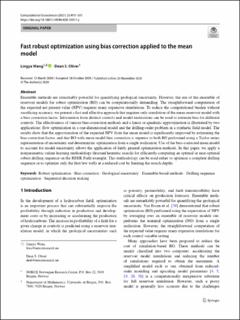| dc.contributor.author | Wang, Lingya | |
| dc.contributor.author | Oliver, Dean | |
| dc.date.accessioned | 2021-03-26T08:04:16Z | |
| dc.date.available | 2021-03-26T08:04:16Z | |
| dc.date.created | 2020-11-26T11:50:16Z | |
| dc.date.issued | 2020 | |
| dc.identifier.citation | Computational Geosciences. 2020, 25 475-501. | en_US |
| dc.identifier.issn | 1420-0597 | |
| dc.identifier.uri | https://hdl.handle.net/11250/2735626 | |
| dc.description.abstract | Ensemble methods are remarkably powerful for quantifying geological uncertainty. However, the use of the ensemble of reservoir models for robust optimization (RO) can be computationally demanding. The straightforward computation of the expected net present value (NPV) requires many expensive simulations. To reduce the computational burden without sacrificing accuracy, we present a fast and effective approach that requires only simulation of the mean reservoir model with a bias correction factor. Information from distinct controls and model realizations can be used to estimate bias for different controls. The effectiveness of various bias-correction methods and a linear or quadratic approximation is illustrated by two applications: flow optimization in a one-dimensional model and the drilling-order problem in a synthetic field model. The results show that the approximation of the expected NPV from the mean model is significantly improved by estimating the bias correction factor, and that RO with mean model bias correction is superior to both RO performed using a Taylor series representation of uncertainty and deterministic optimization from a single realization. Use of the bias-corrected mean model to account for model uncertainty allows the application of fairly general optimization methods. In this paper, we apply a nonparametric online learning methodology (learned heuristic search) for efficiently computing an optimal or near-optimal robust drilling sequence on the REEK Field example. This methodology can be used either to optimize a complete drilling sequence or to optimize only the first few wells at a reduced cost by limiting the search depths. | |
| dc.language.iso | eng | en_US |
| dc.rights | Navngivelse 4.0 Internasjonal | * |
| dc.rights.uri | http://creativecommons.org/licenses/by/4.0/deed.no | * |
| dc.subject | Ensemble based methods | |
| dc.subject | Ensemble-based methods | |
| dc.subject | Reservoarmodellering | |
| dc.subject | Reservoir modelling | |
| dc.subject | Boring | |
| dc.subject | Drilling | |
| dc.title | Fast robust optimization using bias correction applied to the mean model | en_US |
| dc.type | Peer reviewed | en_US |
| dc.type | Journal article | en_US |
| dc.rights.holder | © The Authors, 2020 | |
| dc.description.version | publishedVersion | |
| cristin.ispublished | true | |
| cristin.fulltext | original | |
| cristin.qualitycode | 1 | |
| dc.identifier.doi | 10.1007/s10596-020-10017-y | |
| dc.identifier.cristin | 1852749 | |
| dc.source.journal | Computational Geosciences | en_US |
| dc.source.volume | 25 | en_US |
| dc.source.pagenumber | 475-501 | en_US |
| dc.relation.project | Norges forskningsråd: RCN 280473 | |
| dc.subject.nsi | VDP::Geofag: 450 | |
| dc.subject.nsi | VDP::Geosciences: 450 | |

